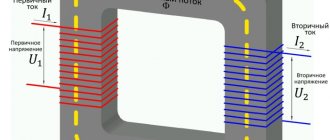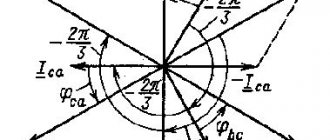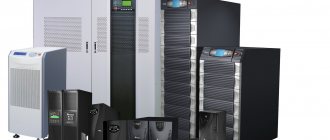The quality of electricity supplied to our homes is not always satisfactory. We often say: “voltage drops”, “voltage jumps”, “voltage surges”, “bad voltage”. Let's understand these concepts together. It should be noted right away that precise determinations of deviations from power quality standards are very complex. In one article it is impossible to provide a complete description of the requirements for electrical parameters and methods for conducting official measurements. The texts of the relevant GOSTs and standards take up dozens of pages and contain numerous complex calculation formulas. In this article we will provide only a general understanding of the basic requirements for power quality and simple descriptions of common deviations
Main indicators of power quality
List of main indicators of electrical energy quality:
- steady voltage deviation;
- voltage change range;
- flicker dose;
- voltage waveform sinusoidal distortion factor;
- coefficient of the nth harmonic component of voltage;
- negative sequence voltage asymmetry coefficient;
- zero sequence voltage asymmetry coefficient;
- frequency deviation;
- duration of voltage dip;
- impulse voltage;
- temporary overvoltage factor.
Voltage deviation
One of the power quality is voltage deviation .
The voltage deviation is determined by the value of the steady-state voltage deviation. The following standards are established for the value of voltage deviation: normally permissible and maximum permissible values of steady-state voltage deviation at the terminals of electricity receivers are equal to +5 and +10%, respectively, of the rated voltage of the electrical network.
The voltage deviation value is determined when the process lasts more than one minute. Normally permissible deviation
voltage is considered to be a range of 5%, that is: +/-5% (from 209 V to 231 V).
The maximum permissible
voltage deviation is considered to be a range of 10%, that is: +/-10% (from 198 V to 242 V).
For the power quality indicators defined above, the following standards apply: positive and negative voltage deviations at the point of transmission of electrical energy should not exceed 10% of the nominal or agreed voltage value for 100% of the time of the one-week interval.
Mandatory requirements
In accordance with Federal Law No. 35 “ On Electric Power Industry ”, subjects of the electric power industry that ensure the supply of electrical energy to consumers of electrical energy, including energy sales organizations, guaranteeing suppliers and territorial network organizations (within the limits of their responsibility), are responsible to consumers of electrical energy for the reliability of the supply their electrical energy and its quality in accordance with technical regulations and other mandatory requirements.
In accordance with the “Basic provisions for the functioning of retail electricity markets (approved by Decree of the Government of the Russian Federation dated 04/05/2012 No. 442) ” : electric power industry entities providing electricity supply to consumers, including suppliers of last resort, energy sales (energy supply) organizations, network organizations, system The operator and subjects of operational dispatch control in technologically isolated territorial electric power systems, as well as producers of electrical energy (capacity), in the course of fulfilling their obligations under contracts concluded by them on the wholesale market and retail markets, jointly ensure in retail markets the reliability of supply to consumers and the quality of electrical power. energy . Requirements for the reliability of power supply and the quality of electrical energy are established in accordance with the legislation of the Russian Federation.
These provisions define the responsibility of both the electric power industry entities that ensure the supply of electrical energy to consumers, and consumers, in the form of mandatory inclusion of essential conditions in contracts for the sale (supply) of electrical energy (power):
- requirements for the quality of supplied electrical energy, which must comply with the requirements of the legislation of the Russian Federation;
- the consumer’s obligation to maintain, at the balance sheet boundary, the values of electric energy quality indicators determined by the operation of his power receiving devices, in accordance with the requirements of the legislation of the Russian Federation, to comply with the values of the ratio of active and reactive power consumption for individual power receiving devices (groups of power receiving devices) of the consumer, determined in accordance with an agreement for the provision of services for the transmission of electrical energy, concluded by the supplier of last resort in the interests of this consumer.
Voltage fluctuation
One of the power quality parameters is voltage fluctuation.
Voltage fluctuations are characterized by the following indicators:
- voltage change range;
- dose of flicker.
The voltage fluctuation values have the same standards as the voltage deviation with the only difference: the process duration is less than one minute. Normally permissible fluctuation
voltage is considered to be a range of 5%, that is: +/-5% (from 209 V to 231 V).
The maximum permissible
voltage fluctuation is considered to be a range of 10%, that is: +/-10% (from 198 V to 242 V).
Comment:
Do not confuse the GOST requirements for the quality of electricity in the network (GOST R 54149-2010 “Electric energy. Electromagnetic compatibility of technical equipment”) and GOSTs describing the quality of power supply for electrical appliances (for example, GOST R 52161.2.17-2009 “Safety of household and similar electrical appliances"). GOST power quality essentially imposes requirements on the supplier of electrical energy, and it is this GOST that you can rely on if you need to make demands on the supplier in case of poor power supply. And the requirements for the quality of power supply in the passports of devices determine the requirement for devices to operate normally in a wider range of current parameter values. For devices, as a rule, a voltage range is set from -15% to +10% of the nominal one.
Electromagnetic compatibility of electrical equipment
Electromagnetic compatibility of electrical equipment and electrical networks is understood as the ability of electrical energy consumers to function normally and not introduce unacceptable distortions into the electrical network that impede the work of other consumers.
If we talk about electrical compatibility in the broadest sense, then this should include all material manifestations and ideal consequences associated with charged particles and electromagnetic fields.
In a narrower sense, electromagnetic compatibility is understood as a set of electric, magnetic and electromagnetic fields that generate electrical objects created by man and which affect dead (physical) and living (biological) nature, technical, informational, social reality.
The latter, in particular, includes bioelectromagnetic compatibility, which consists in the emergence of zones of increased danger due to the conditions of electrostatic and electromagnetic influence.
For technical devices, the deterioration of the electromagnetic environment can become so severe that their functioning may be disrupted, the quality of electricity may deteriorate, and damage to relay protection and automation devices may occur.
The concept of quality of electrical energy differs from the concept of quality of other goods. The quality of electricity is manifested through the quality of operation of each electrical receiver. Therefore, if it works unsatisfactorily, and in each specific case an analysis of the quality of electricity consumed gives compliance with GOST, then the quality of manufacturing or operation is to blame.
If the PKE do not meet the requirements of GOST, then claims are made against the supplier - the energy company.
In general, PCEs determine the degree of voltage distortion in the electrical network due to conducted interference (distributed across the elements of the electrical network) introduced by both the energy supply organization and consumers.
Voltage dip
One of the power quality parameters is voltage dip. The voltage dip is determined by the voltage dip time indicator.
Limit value
The duration of a voltage dip in electrical networks with voltages up to 20,000 V inclusive is 30 seconds. The duration of an automatically eliminated voltage dip at any point of connection to electrical networks is determined by the time delays of the relay protection and the response time of the automation.
A voltage dip is determined when the voltage drops to a value of 0.9U and is characterized by the duration of the process. The maximum permissible duration is 30 seconds. The depth of the failure can sometimes reach 100%.
What affects the characteristics of the power supply network
The quality of electricity is influenced by a fairly large list of factors:
- regular voltage drops as a result of connecting large loads;
- icing of supply lines;
- increased air humidity;
- the quality of electrical lines, the end of their operational period, their failure;
- At sea stations, ebb and flow tides are taken into account.
When it comes to wind farms, the quality of electricity can be adversely affected by changes in the direction and strength of wind flows.
How to improve power quality
In case of significant deviations in power quality parameters, you should first contact the service organization, the electricity supplier. If administrative actions to improve the quality of electricity do not produce results, then it is necessary to use special means of protection. To improve power quality parameters, we recommend using: surge protection, voltage stabilizers, uninterruptible power supplies.
What happens when you deviate from normal diets
The power, performance and service life of electrical devices, especially on an industrial scale, directly depend on the quality of the supplied energy resource. A decrease in the efficiency of highways leads to an increase in electricity consumption. In appliance motors, the rotational torque decreases, lighting fixtures regularly flicker, and all types of lamps quickly fail.
Research in the field of physics has long shown that with a constant load on the engine, a decrease in voltage leads to a rapid increase in current strength, which negatively affects the performance, performance and service life of household appliances and other electrical devices. This leads to the combustion of electronic boards, and wires with insulating material may melt.
Types of protection against unpredictable changes in network parameters
Devices for protection against voltage surges
The energy supply company must take care of the proper quality of the services supplied, which comply with established regulatory documents. But at the same time, each homeowner can personally protect their household appliances from power surges with special types of equipment:
- Uninterruptible power sources are capable of maintaining the operating condition of certain types of household appliances for a given time. For example, connecting such a device to a computer allows it to shut down correctly and save all the required files.
- Equipment designed to protect against voltage surges. The operating principle is similar to that of a relay. If one of the parameters of the electrical circuit reaches critical levels, the room is automatically de-energized.
- The voltage stabilizer controls that the voltage does not go beyond the specified parameters. Provides adequate power quality, but provided that deviations do not exceed 35%.
It is recommended to purchase equipment designed to protect household appliances in specialized stores. The electrical device must be accompanied by accompanying documentation and a warranty card.
annotation
Power quality is an aspect of the electrical power industry that has been known to us since the inception of power systems. However, power quality topics have risen to the forefront since the advent of high-power semiconductor switches and transmission networks. In addition, the trends in modern power generation are to extract maximum benefit from the existing installed system and this has also emphasized issues of sine waveform accuracy, lack of high and low voltage conditions and other AC waveform distortion.
This article describes the types of power quality variations and presents methods that characterize each type with measurements. In addition, advances in power quality monitoring and tools for analyzing power quality measurement results are presented. The increasing volume of data collected requires more advanced analysis tools.
Causes of frequency deviation in electrical systems
As is known from the TOE course, in normal steady state, the total power generated by all generators in the electrical system must be exactly equal to the total power of all electrical receivers connected to the system at the moment. In this case, the rotation speed of the system generators (and they all rotate synchronously), and therefore the frequency
in the electrical system, must remain constant and equal to the nominal
−
50 Hz (in the USA, Japan and a number of other countries 60 Hz).
Any imbalance between generated and consumed power causes a change in the rotation speed of the generators, i.e., the frequency in the system.
In case of emergency shutdown
one (several) generators or
connecting
powerful loads in the system, there is a shortage of active power.
The electrical load (their current output) on the generators remaining in operation increases. At the same time, the turbines of these generators begin to slow down, which leads to a decrease
in the frequency in the system.
Automatic frequency regulators (AFCs) increase the supply of steam to turbines (or water to hydraulic turbines) and their speed (power) increases; accordingly, the voltage frequency generated by working generators increases to the nominal value.
Such frequency maintenance is possible only if there is an active power reserve in the generators, that is, if the generators were partially underloaded until the moment in question. If all power reserves are exhausted, the system cannot restore frequency.
When disconnected
powerful loads, excess generated power appears in the system, since the power generated by the generator turbines at the first moment remains unchanged, which leads to
an increase
in their speed and, accordingly, the frequency in the system. At the same time, the speed regulators of the steam turbines come into effect, which slightly reduce the steam supply (in hydraulic turbines, the water supply), thereby reducing the power generated by the generator until a new power balance is achieved in the system.
The speed controllers of steam turbines operate quite quickly, so load shedding leads to a slight increase in frequency and its rapid restoration to the nominal value. In hydraulic turbines, regulators act more slowly and their rotation speed (frequency) can increase to 120 - 140%.
19) The influence of frequency deviation on the operation of electrical receivers, the requirements of regulatory documents for frequency deviations.
The influence of frequency deviation on the operation of electrical receivers and electrical systems
A slight decrease in frequency (a few tenths of a hertz) does not pose a serious problem for the electrical system, but such a decrease in frequency does not have a favorable effect on the operation of consumers. As the frequency decreases, the rotation speed of electric motors (especially asynchronous ones) and, accordingly, the performance of the mechanisms they drive decrease.
At some enterprises, a deviation from the nominal frequency can lead to disruption of production technology; a decrease in frequency by 3–5% disrupts the operation of radio equipment and a number of automatic control devices. As the frequency decreases, the reactive power of transformers and rotating machines increases sharply, which reduces the efficiency of electrical networks.
A decrease in frequency has an extremely negative effect on the operation of thermal power plants. So, for example, a decrease in frequency by 3–5 Hz entails a 20–40% reduction in the supply of water to the condenser by circulation pumps. This leads to a decrease in the available power (the power that can be generated) of the station, which in turn leads to a further drop in the frequency in the system. This dangerous phenomenon is called “frequency avalanche”.
Requirements of regulatory documents for AFR devices
According to the PUE [11], the automatic frequency reduction device must prevent the operation of the electrical system at frequencies below 45 Hz, the operating time with a frequency below 47 Hz should not exceed 20 s, and with a frequency below 48.5 Hz - 60 s.
GOST for power quality [8] normalizes the following frequency deviations:
— normally permissible deviations (in normal operating modes)
±0.2 Hz;
— maximum permissible deviations (in post-emergency modes)
±0.4 Hz.
Operating principle of AFR, categories and queues of AFR
Operating principle of the AChR
An emergency reduction in frequency caused by a sudden significant deficit of active power is fleeting in nature - a few seconds. Therefore, only automation can counter this decline. Initially, the automation uses all active power reserves in the system. Serviceable generators of the system take on the maximum load (taking into account permissible short-term overloads).
If after these automatic actions the frequency continues to decrease (which indicates an active power deficit that has not been eliminated), the only way to equalize the amounts of generated and consumed power is to turn off some of the least critical power receivers.
Such shutdowns are carried out by special electrical automation devices - frequency shedding machines - AFRs.
AFR devices, as a rule, are installed at substations of the electrical system; they can be installed directly at consumers, but under the control of the electrical system [8].
PUE [8] divides AChR devices into two categories: AChRI I and AChRI II.
First category – АЧРI
designed to prevent a deep decrease in frequency at
the initial moment of the accident development
.
These devices are fast-acting (with time delays tAFR
≤ 0.5 s) and frequency response settings from 47 - 48 Hz to 46 - 46.5 Hz. To implement ACPI, consumers are disconnected in small groups, according to priority. The first-stage power receivers are switched off, for example, when the frequency drops below 48 Hz. If the frequency decrease continues, the power receivers of the second stage are switched off with a setting of 47.5 Hz, then the third - with a setting of 47 Hz. The minimum difference in the frequency settings of the nearest queues is assumed to be 0.1 Hz. AChRI is equipped with approximately 75 - 80% of the total electrical load equipped with AChRI.
Second category – AChRIII
designed to restore the frequency if it
remains low for a long time
, figuratively speaking, “freezes” at a level of about 48 Hz. The frequency settings for ACHRII are taken to be the same and 0.5 Hz higher than the upper setting for ACHRI. Unlike AChRI, significant time delays are introduced into the operation of AChRI II in the range of 15 – 90 s, differing from each other by 5 s. Such relatively long shutter speeds are necessary to connect power reserves, in particular, to start hydrogenerators. Approximately 20–25% of the total electrical load equipped with AChRII devices are equipped with AChRII devices.
21) Electrical diagram of the AFR device on electromechanical
relay, circuit operation.
In Fig.
Figure 7.1 shows a diagram of an AFR device using a constant operating current using electromechanical or electronic relays. KF frequency relay
(electromechanical type IVCh-3 with induction operating principle or electronic type URCH-3M).
KF
relay controls the frequency of the primary network through the measuring voltage transformer
TV
.
When the frequency drops below the set point, the KF
closes its contact in the
KT
.
The direct operating voltage generated by the UGV
(for example, type BPZ-401) is supplied to the winding of the
KT
(type EV-100 or VL-68).
The latter, after a given time delay, will close its contact KT
in the circuit of windings of the indicating relay
KH
(type RU-21) and the intermediate relay
KL (
type RP-23). A detailed description of these relays is given in laboratory work 1 and 2.
The intermediate relay closes its contacts KL1 and KL2,
by sending trip commands to the breaker actuators
Q1
and
Q2.
The switches operate, turning off the electrical receivers connected through them.
Closed contacts KL3
form a command to prohibit automatic reclosure.
KH
indicator relay signals the maintenance personnel about the fact of operation of the AFR device.
Causes of voltage surges in the private sector
If the consumer lives in his own home, then the most common reasons for deterioration in voltage quality are: damage to the power line, short circuit to ground, burnout of the neutral conductor in the transformer substation (TS) and lightning.
It often happens that the voltage in the network is much lower than 230 V and the light bulbs burn very dimly. One of the reasons is the voltage drop along the line. The more houses and thus the load are connected on the line, the lower the voltage will be in houses remote from the transformer substations.
For example, at the beginning of the street there is a transformer substation. In the first houses from the TP the voltage can be 235 V, and in the last 195 V, which is permissible according to the rules. In order to somehow reduce the load on the line, power engineers unload it by distributing the load between adjacent phases or increasing the cross-section of power lines (power lines). But they can also increase the output voltage from the transformer substation, for example, to 240 V. This is also bad for the first houses, but within normal limits.










